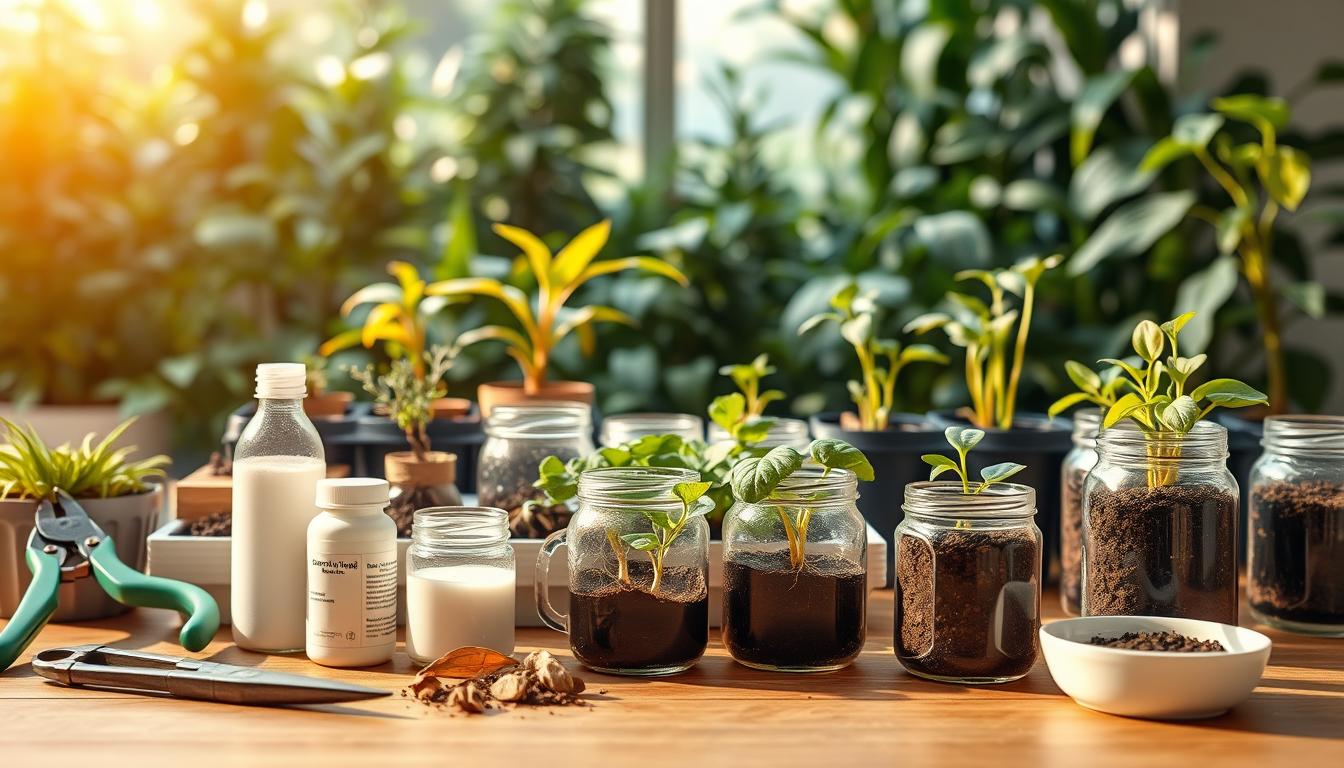Ready to explore the world of plant propagation? Learn how to grow more plants from the ones you love. It’s key for anyone wanting to grow their plant collection. You’ll discover techniques like asexual and vegetative propagation, seed, cutting, and grafting.
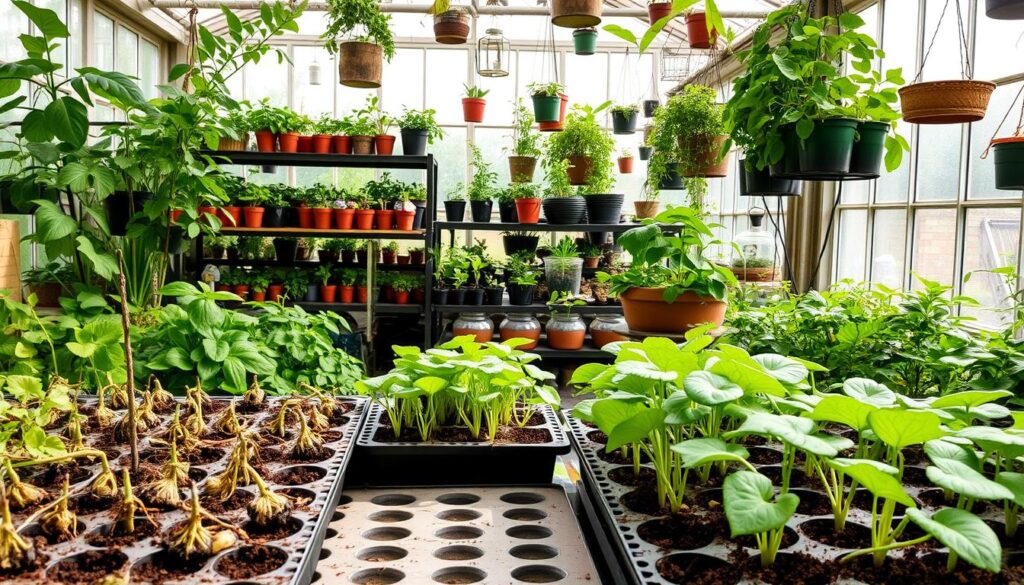
This guide is for both new and experienced gardeners. It will teach you how to make new plants from your old ones. You can share them with others or grow your collection. With practice, you’ll master the art of plant propagation.
Key Takeaways
- Learn the essential methods of plant propagation, including asexual propagation and vegetative propagation.
- Discover the benefits of using different plant propagation techniques, such as seed propagation and cutting propagation.
- Understand the importance of selecting healthy rootstock and scions for successful grafting.
- Explore the various types of grafting methods, including cleft grafting, whip and tongue grafting, and budding.
- Get tips on how to create the ideal growing environment for your newly propagated plants using effective plant propagation methods.
- Learn how to troubleshoot common propagation problems and recover from setbacks using various plant propagation techniques.
- Find out how to use rooting hormones and other tools to increase your chances of successful plant propagation using different plant propagation methods.
Understanding the Basics of Plant Propagation Methods
Plant propagation is a process with two main parts: sexual and asexual. Asexual propagation uses parts like stems, leaves, or roots to grow new plants. This method is loved by gardeners because it makes new plants just like the original.
Stem cuttings are a common way to propagate plants. They work well for many types of plants. Layering and air layering are also used to grow new plants from branches.
Knowing about plant propagation is key to growing your plants well. By learning about asexual propagation and vegetative propagation, you can increase your chances of success. This way, you can enjoy the many benefits of growing your own plants.
Essential Tools and Materials for Successful Propagation
To succeed in plant propagation, you need the right tools and materials. Quality plant propagation resources are key. You’ll need a sharp grafting knife, pruning shears, grafting tape or rubber bands, and rooting hormone. Also, a good potting mix, a clean workspace, and a propagation tray or container are crucial.
Having the right tools and materials is just the start. You must also know the specific needs of your plants. Some plants need more humidity or light. Using the right tools and following best plant propagation practices will help your plants thrive.
Here are some essential tools and materials for plant propagation:
- Pruning shears
- Grafting knife
- Rooting hormone
- Potting mix
- Propagation tray or container
Investing in these tools and materials, and following best plant propagation practices, will help you succeed. You’ll enjoy growing your own plants.
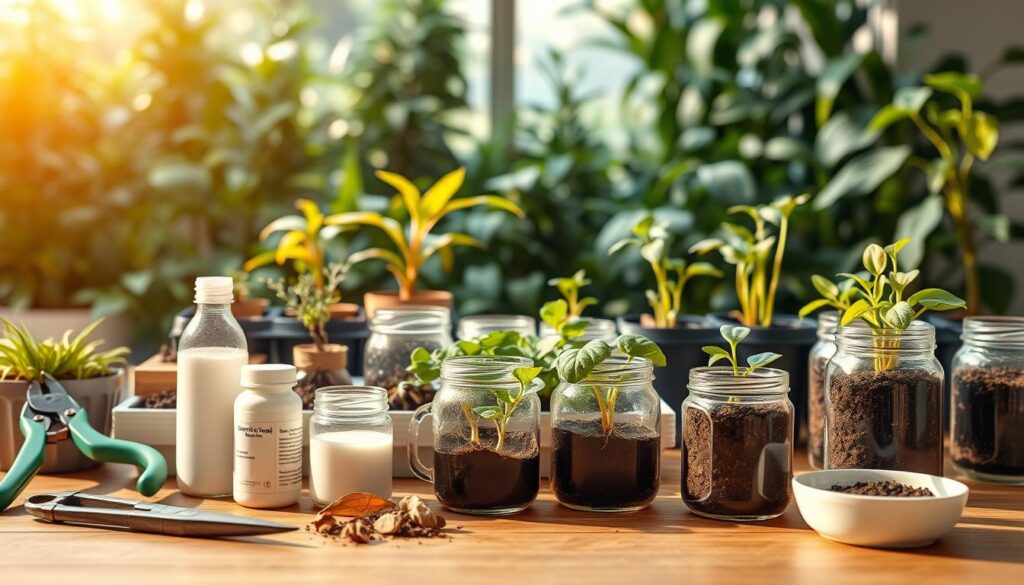
Seed Propagation: From Selection to Sprouting
Choosing the right seeds is key for seed propagation success. You need seeds that fit your climate and the plant you want to grow. Think about growth habits, lighting, and temperature to pick the best seeds.
Seed propagation uses seeds to grow new plants. It leads to more genetic diversity. This means plants can be more resilient and adaptable.
How you prepare and store seeds affects their viability and germination. Techniques like seed scarification and stratification can help seeds germinate better. Using graded, primed, and pelleted seeds also impacts germination success.
Seed propagation takes more time and effort than cutting propagation. But it brings benefits like more genetic diversity and adaptability.
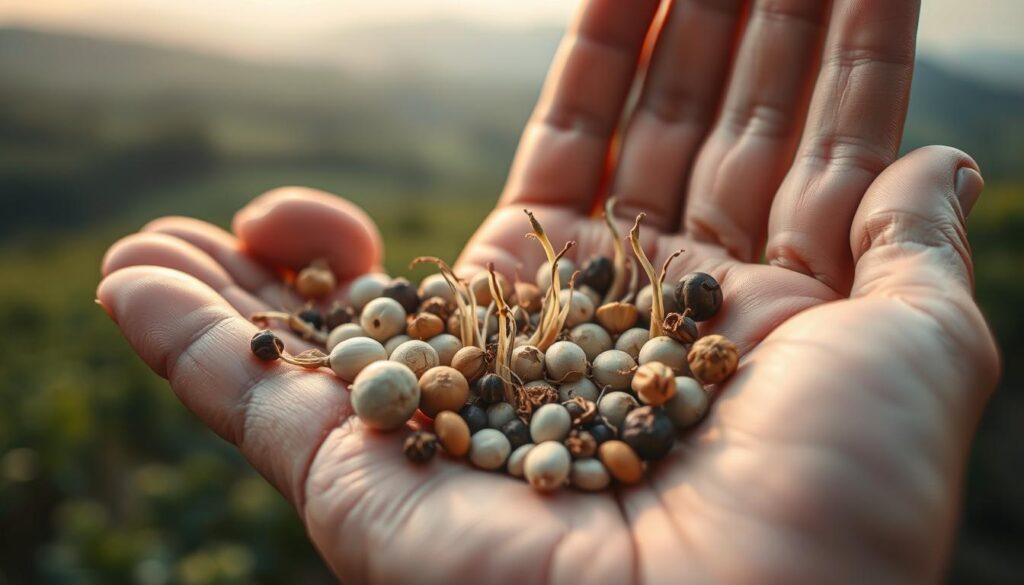
- Seed quality and viability
- Proper storage and handling
- Optimal germination conditions, such as temperature and lighting
- Techniques for breaking seed dormancy, such as seed scarification and seed stratification
By following these tips and using the right techniques, you can boost seed propagation success. Whether you choose seed or cutting propagation, the goal is to create the best conditions for your plants to grow.
The Science Behind Vegetative Propagation
Vegetative propagation uses parts like stems, leaves, or roots to grow new plants. It’s a favorite among gardeners because it makes new plants just like the parent. This method shows the beauty and complexity of plant growth.
This method solves seed dormancy issues and shortens the nonflowering stage in some plants. It also makes plants genetically identical, which is key for disease resistance. This is crucial for plants that easily get sick.
Examples of vegetative propagation include stolons, rhizomes, and tubers. Stolons, like in strawberries, grow roots and new plants when they touch moist soil. Rhizomes, found in plants like iris and ginger, help plants multiply by branching. Tubers, like potato eyes, grow into new plants under the right conditions.
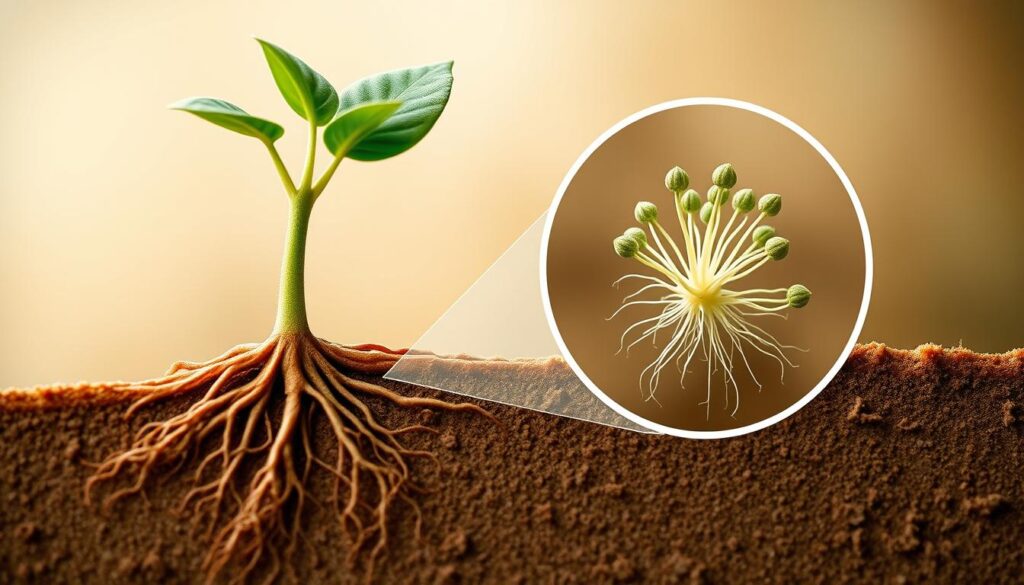
Many plants naturally use vegetative propagation, like willows and poplars. Cacti and succulents often grow back from broken pieces. Knowing how vegetative propagation works lets you grow healthy, disease-resistant plants that are genetically the same as the parent.
Some main benefits of vegetative propagation are:
- Eliminates seed dormancy problems
- Reduces the juvenile nonflowering stage of some seed-propagated plants
- Results in horticultural plants that are exact genetic clones
- Allows for the creation of new plants that are resistant to disease
Mastering Cutting Propagation Techniques
Exploring plant propagation, you’ll find cutting propagation is a favorite. It uses cuttings to grow new plants. You can use softwood, hardwood, or root cuttings. To get good at it, knowing the best conditions for rooting is key.
Research shows the best temperature for rooting cuttings is 70–74 degrees Fahrenheit. Keeping the humidity and moisture right in the medium is also important. With the right steps and materials, you can succeed in cutting propagation. This way, you can grow your own plants using cutting and grafting methods.
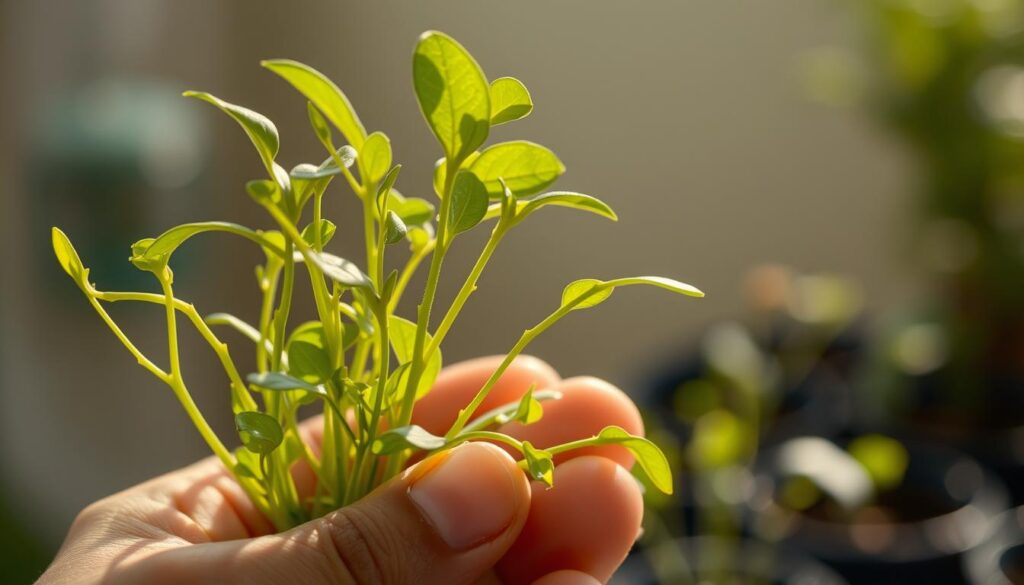
- Maintaining optimal temperature and humidity levels
- Using the right type of cutting for the plant species
- Applying fertilizer only after roots have formed
- Practicing effective sanitation and environmental control
Mastering these techniques lets you grow new plants easily. You’ll enjoy the savings of gardening through propagation.
Advanced Grafting and Budding Methods
Exploring plant propagation reveals grafting’s key role in growing stronger plants. Grafting merges two plants’ best traits, like disease resistance and better growth. There are many resources available to learn grafting and budding.
Advanced grafting techniques include whip-and-tongue, cleft, and chip budding. Whip-and-tongue grafting works best, with a 95.8% success rate. Cleft and chip budding have 66.7% and 50.0% success rates, respectively. Knowing these methods helps you pick the right one for your needs.
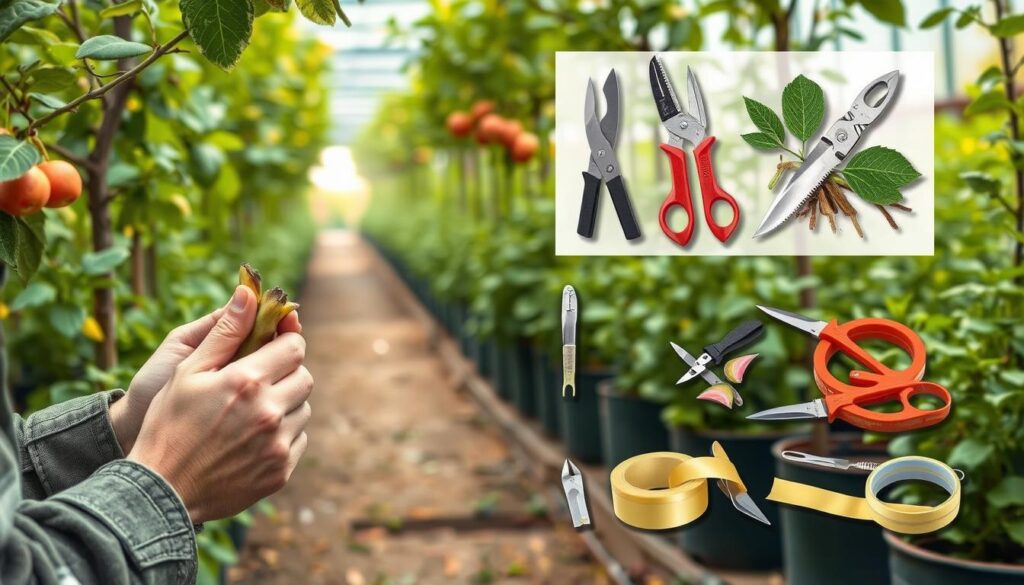
Budding offers several techniques, like T-budding, chip, and patch budding. These are great for beginners and work well with many plants, including roses and fruit trees. Learning grafting and budding can enhance your plants’ health and productivity.
With time and effort, you can master advanced grafting and budding. This skill lets you create plants that meet your specific needs. Exploring plant propagation resources and grafting methods will help you become a skilled plant propagator.
Division and Layering: Natural Propagation Approaches
Exploring plant propagation techniques shows that division and layering are natural ways. They use roots and stems to grow new plants. These methods are loved by gardeners because they make genetically identical plants. By following best plant propagation practices, you can boost your chances of success.
Division means splitting a plant into two or more parts, each with its own roots and stems. It’s great for most perennials as they get older. Layering, however, bends a stem to the ground to grow a new plant. There are different layering techniques, each with its own way of developing roots.
Some plants are easier to divide or layer than others. For instance, Agave and yucca can be split using offsets. Houseplants like Pilea peperomioides and aloe can also be split from offsets. Strawberry plants, many ground covers, grasses, and some weeds use stolons for growth. Suckers are used by native shrubs like Virginia sweetspire, sweet pepperbush, spicebush, and witch alder for propagation.
Learning division and layering lets you grow your own plants naturally. Remember to stick to best plant propagation practices for success. With these methods, you can make new plants just like the original. This way, you can share your favorite plants with others.
| Propagation Method | Success Rate | Time to Root |
|---|---|---|
| Layering | Generally higher than cuttings or divisions | Several weeks to a year |
| Division | Varies depending on plant species | Several weeks to a year |
Water Propagation: Growing Plants in Liquid Medium
Exploring plant propagation methods might lead you to water propagation. It’s a way to grow plants in liquid. This asexual propagation method makes new plants just like the parent. It’s a favorite among gardeners for many plants, especially indoor ones.
Popular indoor plants like Aroids, such as Pothos and Philodendron, do well in water. For success, cuttings should have at least two nodes and leaves. Roots grow faster in water than in soil, and they should be 3 cm to 5 cm long before moving to soil.
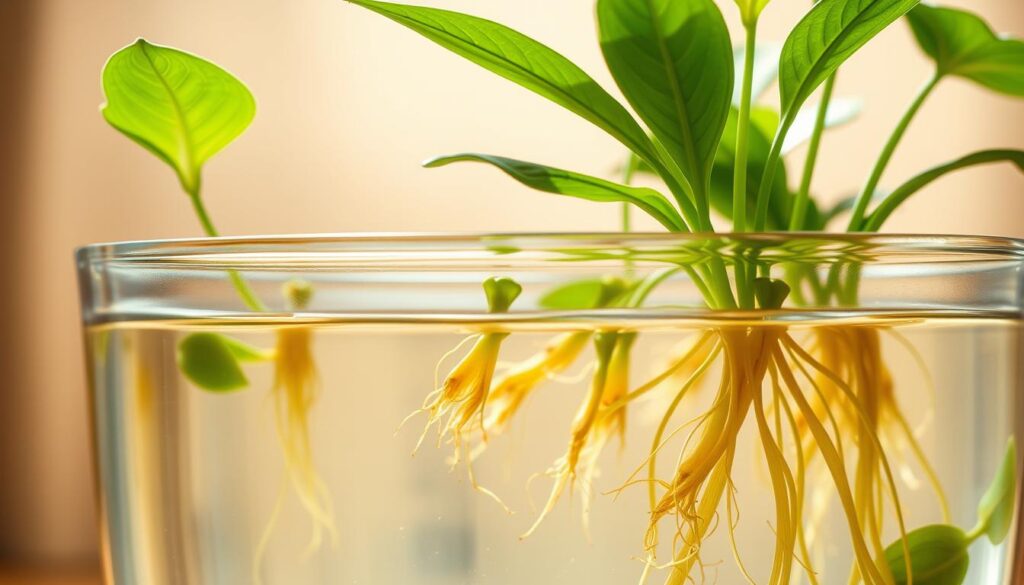
For your cuttings to thrive, they need the right conditions. Change the water in the vessel weekly to keep oxygen and nutrients flowing. Using a rooting hormone like Clonex can also help. With the right approach, you can grow your plants in water and enjoy the process.
Here are some tips for water propagation:
- Remove bottom leaves near the node to prevent rotting in water
- Avoid having too many leaves on the cutting, as this can reduce the chance of successful rooting
- Place rooting plants in an area with bright indirect light for optimal growth
Troubleshooting Common Propagation Problems
Starting with plant propagation can lead to some common issues. It’s key to know the best practices and use trusted resources. This way, you can tackle problems that might harm your plants’ health and growth.
Disease, pests, and stress are common problems. To avoid disease, keep your area clean and use sterilizing tools. Also, make sure your plants have the right temperature, humidity, and light. This helps prevent stress and promotes growth.
For recovery, act fast and be proactive. You might need to prune affected areas, adjust watering, or add nutrients. These steps can help your plants bounce back and flourish.

- Watch your plants for stress or disease signs
- Keep a journal to track your progress and find ways to get better
- Stay current with the latest in plant propagation
By following these tips and staying dedicated, you’ll overcome common problems. This will help you succeed with your plants.
Creating the Ideal Growing Environment
To succeed in plant propagation techniques, you need to create an ideal growing environment for your plants. This means giving them the right conditions for growth. This includes light, temperature, water, and nutrients. Asexual propagation methods, like cuttings and division, need specific conditions to thrive.
Some key factors to consider when creating the ideal growing environment include:
- Light: Most plants need bright, indirect light to photosynthesize and grow.
- Temperature: The ideal temperature range for plant growth is between 65-75°F (18-24°C). Some plants may need warmer or cooler temperatures.
- Water: Overwatering can harm plant growth. It’s crucial to find the right balance of moisture and drainage.
- Nutrients: Plants need a balanced diet of nutrients to grow strong and healthy.
By understanding your plants’ specific needs and providing the right conditions, you can create an ideal growing environment. This environment promotes healthy plant growth and increases the chances of successful asexual propagation. Always research the specific requirements for your plant species and adjust the environment accordingly.
Conclusion: Your Journey to Propagation Success
Starting your plant propagation journey is exciting. It brings joy and satisfaction as you create new plants. By learning the key methods, you can grow more of your favorite plants. This lets you share them with others, spreading greenery and happiness.
Plant propagation is more than just a skill. It’s a fulfilling experience. With the right tools and patience, your plants will grow strong. You’ll also learn more about plants and leave a lasting mark.
FAQ
What are the essential methods of plant propagation?
Key methods include asexual and sexual propagation. Asexual uses stems, leaves, or roots. Sexual uses seeds. Cutting and grafting are also important.
What is the difference between sexual and asexual propagation?
Sexual uses seeds. Asexual uses stems, leaves, or roots to grow new plants.
Why is it important to have the right tools and materials for successful plant propagation?
The right tools, like a sharp knife and good potting mix, are crucial. They help ensure your plants grow well.
What are the key considerations when selecting and preparing seeds for propagation?
Consider growth habits, lighting, and temperature when choosing seeds. Proper storage and preparation are also key for success.
How does the science behind vegetative propagation work?
It uses hormones to grow new plants from stems and leaves. This creates plants that are genetically the same.
What are the different types of cuttings used in cutting propagation, and how do they differ?
Cuttings include softwood, hardwood, and root types. Each has its own benefits and challenges.
What are the advanced grafting and budding methods used in plant propagation?
Techniques like cleft grafting and budding create plants with desirable traits. These include disease resistance and improved growth.
How do division and layering techniques work in plant propagation?
Division splits a plant into parts with roots and stems. Layering bends a stem to create a new plant.
What are the benefits of water propagation, and how does it work?
Water propagation uses water or nutrients to grow plants. It creates genetically identical plants.
How can you troubleshoot common propagation problems?
To solve problems, prevent disease and control the environment. Use recovery techniques for healthy plants.
What are the key factors in creating an ideal growing environment for plant propagation?
The right environment includes proper light, temperature, water, and nutrients. This promotes healthy growth and successful propagation.
Source Links
- Plant Propagation for Home Gardeners, Part 2: A Comprehensive Guide to Grafting Methods – https://ucanr.edu/blogs/blogcore/postdetail.cfm?postnum=61433
- Plant Propagation Methods – Resource Central – https://resourcecentral.org/plant-propagation-methods/?srsltid=AfmBOoo40InHK3VXdMulQMKjMe0qV6-LTmhQFzNGcbSaroaq_guS-brt
- How to Propagate Houseplants by Stem Tip Cuttings – https://yardandgarden.extension.iastate.edu/how-to/how-propagate-houseplants-stem-tip-cuttings
- Plant Propagation Methods – Resource Central – https://resourcecentral.org/plant-propagation-methods/?srsltid=AfmBOop7nn4jQfMYHc-G1GaY1Znlid5K3IbBGY0vvoyw6HbQaU6gJP-F
- What is plant propagation and why is it important? – https://www.haxnicks.co.uk/blogs/grow-at-home/what-is-plant-propagation-and-why-is-it-important?srsltid=AfmBOoo6iC3_aeLmi9vaqDwiTva3pKp-n516xThoS3emNJHzXifh6_19
- How To Propagate Plants – https://www.gardeningknowhow.com/garden-how-to/propagation/propgen/types-of-plant-propagation.htm
- Propagation Perfection: How to Grow Your Garden for Free! – https://livingcolorgardencenter.net/gardening/how-to-propagate-plants/
- Get the Best Tools for Plant Propagation – Leafgreen Gardens – https://www.leafgreengardens.com/get-the-best-tools-for-plant-propagation/
- Plant propagation equipment: 16 necessary and nice to have gardening tools – Plantilio – https://plantilio.com/plant-propagation-equipment/
- Plant Propagation from Seed – https://www.greenhouse-management.com/greenhouse_management/greenhouse_management_chapters/ch24_plant_propagation_seed.htm
- Types of Plant Propagation Techniques – Plant Cell Technology – https://plantcelltechnology.com/blogs/blog/types-of-plant-propagation-techniques?srsltid=AfmBOoqJxktuuzNkUedg880WiAK37IWKUUvJIwq5oLqhFCa0WojUtDs2
- Plant Propagation for Home Gardeners: A Comprehensive Guide – https://ucanr.edu/blogs/blogcore/postdetail.cfm?postnum=61052&sharing=yes
- Horticulture – Propagation, Plant Breeding, Cultivation | Britannica – https://www.britannica.com/science/horticulture/Propagation
- Vegetative reproduction | Description, Types, Horticulture, Examples, & Facts | Britannica – https://www.britannica.com/science/vegetative-reproduction
- Vegetative plant parts – https://extension.oregonstate.edu/gardening/techniques/vegetative-plant-parts
- Mastering Nursery Propagation: Vital Tips for Plant Enthusiasts – https://www.dynastytreeexperts.com/blog/growing-green-mastering-nursery-propagation-for-a-thriving-garden/
- Propagation by Cuttings: Wounding vs Heel Cutting – Organic Gardening – https://www.groworganic.com/blogs/articles/propagation-by-cuttings-wounding-vs-heel-cutting?srsltid=AfmBOopjSYSPFOrmpqROus_OK9kAVupxEpB1VNFV-lySeW_TH8iGlr4N
- No title found – https://journals.ashs.org/horttech/view/journals/horttech/34/6/article-p653.xml
- Difference between Budding and Grafting – An Overview – %%sitename%% – GeeksforGeeks – https://www.geeksforgeeks.org/difference-between-budding-and-grafting/
- Plant Propagation: Creating New Plants by Layering – https://piedmontmastergardeners.org/article/plant-propagation-creating-new-plants-by-layering/
- Plant Propagation Methods – Resource Central – https://resourcecentral.org/plant-propagation-methods/?srsltid=AfmBOoo1rvnU8YbiuvkuhHIy86OG7I3Vznc7qtEcMfYyXByncX2l63Kp
- Types of Plant Propagation Techniques – Plant Cell Technology – https://plantcelltechnology.com/blogs/blog/types-of-plant-propagation-techniques?srsltid=AfmBOoqHD_ytejXQl3yuEkkvkdGXo6BUZYID0KhDxdvDwRB5WfnwThZG
- How to water propagate indoor plants (the simple step-by-step guide with photos) – https://www.lovethatleaf.co.nz/blogs/plant-care-guides/how-to-water-propagate-indoor-plants?srsltid=AfmBOorpWkPKywu6PH4frgg3u5a63dyl6ckiy6C0iO_4XWrsKzmfOhU9
- how to root plant cuttings in water for propagation – https://cleverbloom.com/root-plant-cuttings-water/
- Plant Propagation Methods – Resource Central – https://resourcecentral.org/plant-propagation-methods/?srsltid=AfmBOoo5Ihv-9yzkjBy1YEejUVWLHCN_hMjWkOb9IXgaZ3964YO1Ma4K
- Most Common Mistakes When Propagating Plants From Cuttings – https://hormex.com/blogs/plant-growth-101-blog/most-common-mistakes-when-propagating-plants-from-cuttings?srsltid=AfmBOoq56Oo8pm3wfDAhTIQQcXLUC8Hp6Zp8lt2hZF3hQ3nb0a8-XzhR
- Types of Plant Propagation Techniques – Plant Cell Technology – https://plantcelltechnology.com/blogs/blog/types-of-plant-propagation-techniques?srsltid=AfmBOooTOMizJEAehq9DMchMZqlPLWHBDQjPVQ5ukGePuZHuxYgZMxpV
- Propagation tips for rare and exotic plants: A specialist’s guide – https://growcycle.com/learn/propagation-tips-for-rare-and-exotic-plants-a-specialists-guide?srsltid=AfmBOoqrGYiA5CzVOIuOshcFSLMvxu8e3hAu4ftz658Cu-zCeGdi2Pnx
- Plant Propagation – https://ucanr.edu/blogs/blogcore/postdetail.cfm?postnum=60184
- Propagation | Seeds, Cuttings & Layering | Britannica – https://www.britannica.com/science/propagation-of-plants
- How to Master Peace Lily Propagation in 5 Easy Steps – https://www.plantsmile.com/how-to-master-peace-lily-propagation/
- Propagating Roses: An Overview of Six Effective Methods – Fraser Valley Rose Farm – https://www.fraservalleyrosefarm.com/rose-propagation-methods-chart/?srsltid=AfmBOool03KGAKbKG10QxVjCptCm0ILP0Dmv9I9LaR5Y_eSjQx9_dGrL

